Input interpretation

H_2O water + KI potassium iodide + KClO_3 potassium chlorate ⟶ KOH potassium hydroxide + I_2 iodine + KCl potassium chloride
Balanced equation

Balance the chemical equation algebraically: H_2O + KI + KClO_3 ⟶ KOH + I_2 + KCl Add stoichiometric coefficients, c_i, to the reactants and products: c_1 H_2O + c_2 KI + c_3 KClO_3 ⟶ c_4 KOH + c_5 I_2 + c_6 KCl Set the number of atoms in the reactants equal to the number of atoms in the products for H, O, I, K and Cl: H: | 2 c_1 = c_4 O: | c_1 + 3 c_3 = c_4 I: | c_2 = 2 c_5 K: | c_2 + c_3 = c_4 + c_6 Cl: | c_3 = c_6 Since the coefficients are relative quantities and underdetermined, choose a coefficient to set arbitrarily. To keep the coefficients small, the arbitrary value is ordinarily one. For instance, set c_3 = 1 and solve the system of equations for the remaining coefficients: c_1 = 3 c_2 = 6 c_3 = 1 c_4 = 6 c_5 = 3 c_6 = 1 Substitute the coefficients into the chemical reaction to obtain the balanced equation: Answer: | | 3 H_2O + 6 KI + KClO_3 ⟶ 6 KOH + 3 I_2 + KCl
Structures
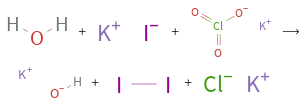
+ + ⟶ + +
Names

water + potassium iodide + potassium chlorate ⟶ potassium hydroxide + iodine + potassium chloride
Reaction thermodynamics
Enthalpy
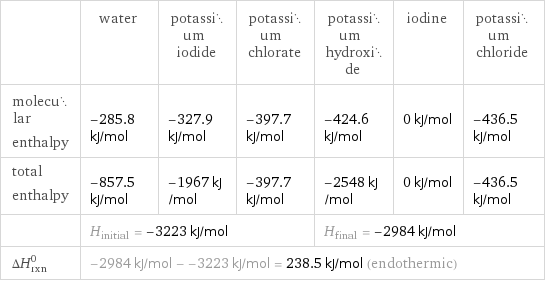
| water | potassium iodide | potassium chlorate | potassium hydroxide | iodine | potassium chloride molecular enthalpy | -285.8 kJ/mol | -327.9 kJ/mol | -397.7 kJ/mol | -424.6 kJ/mol | 0 kJ/mol | -436.5 kJ/mol total enthalpy | -857.5 kJ/mol | -1967 kJ/mol | -397.7 kJ/mol | -2548 kJ/mol | 0 kJ/mol | -436.5 kJ/mol | H_initial = -3223 kJ/mol | | | H_final = -2984 kJ/mol | | ΔH_rxn^0 | -2984 kJ/mol - -3223 kJ/mol = 238.5 kJ/mol (endothermic) | | | | |
Gibbs free energy
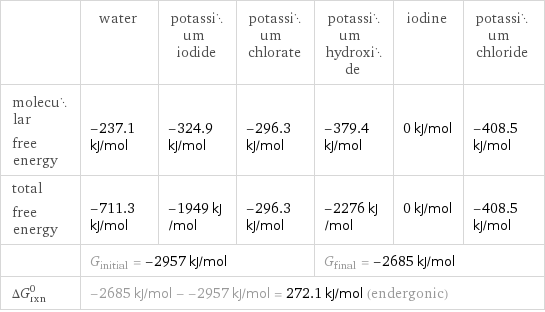
| water | potassium iodide | potassium chlorate | potassium hydroxide | iodine | potassium chloride molecular free energy | -237.1 kJ/mol | -324.9 kJ/mol | -296.3 kJ/mol | -379.4 kJ/mol | 0 kJ/mol | -408.5 kJ/mol total free energy | -711.3 kJ/mol | -1949 kJ/mol | -296.3 kJ/mol | -2276 kJ/mol | 0 kJ/mol | -408.5 kJ/mol | G_initial = -2957 kJ/mol | | | G_final = -2685 kJ/mol | | ΔG_rxn^0 | -2685 kJ/mol - -2957 kJ/mol = 272.1 kJ/mol (endergonic) | | | | |
Equilibrium constant
![Construct the equilibrium constant, K, expression for: H_2O + KI + KClO_3 ⟶ KOH + I_2 + KCl Plan: • Balance the chemical equation. • Determine the stoichiometric numbers. • Assemble the activity expression for each chemical species. • Use the activity expressions to build the equilibrium constant expression. Write the balanced chemical equation: 3 H_2O + 6 KI + KClO_3 ⟶ 6 KOH + 3 I_2 + KCl Assign stoichiometric numbers, ν_i, using the stoichiometric coefficients, c_i, from the balanced chemical equation in the following manner: ν_i = -c_i for reactants and ν_i = c_i for products: chemical species | c_i | ν_i H_2O | 3 | -3 KI | 6 | -6 KClO_3 | 1 | -1 KOH | 6 | 6 I_2 | 3 | 3 KCl | 1 | 1 Assemble the activity expressions accounting for the state of matter and ν_i: chemical species | c_i | ν_i | activity expression H_2O | 3 | -3 | ([H2O])^(-3) KI | 6 | -6 | ([KI])^(-6) KClO_3 | 1 | -1 | ([KClO3])^(-1) KOH | 6 | 6 | ([KOH])^6 I_2 | 3 | 3 | ([I2])^3 KCl | 1 | 1 | [KCl] The equilibrium constant symbol in the concentration basis is: K_c Mulitply the activity expressions to arrive at the K_c expression: Answer: | | K_c = ([H2O])^(-3) ([KI])^(-6) ([KClO3])^(-1) ([KOH])^6 ([I2])^3 [KCl] = (([KOH])^6 ([I2])^3 [KCl])/(([H2O])^3 ([KI])^6 [KClO3])](../image_source/c63e8ba5259d2f6f5bdd11294e6fc1d3.png)
Construct the equilibrium constant, K, expression for: H_2O + KI + KClO_3 ⟶ KOH + I_2 + KCl Plan: • Balance the chemical equation. • Determine the stoichiometric numbers. • Assemble the activity expression for each chemical species. • Use the activity expressions to build the equilibrium constant expression. Write the balanced chemical equation: 3 H_2O + 6 KI + KClO_3 ⟶ 6 KOH + 3 I_2 + KCl Assign stoichiometric numbers, ν_i, using the stoichiometric coefficients, c_i, from the balanced chemical equation in the following manner: ν_i = -c_i for reactants and ν_i = c_i for products: chemical species | c_i | ν_i H_2O | 3 | -3 KI | 6 | -6 KClO_3 | 1 | -1 KOH | 6 | 6 I_2 | 3 | 3 KCl | 1 | 1 Assemble the activity expressions accounting for the state of matter and ν_i: chemical species | c_i | ν_i | activity expression H_2O | 3 | -3 | ([H2O])^(-3) KI | 6 | -6 | ([KI])^(-6) KClO_3 | 1 | -1 | ([KClO3])^(-1) KOH | 6 | 6 | ([KOH])^6 I_2 | 3 | 3 | ([I2])^3 KCl | 1 | 1 | [KCl] The equilibrium constant symbol in the concentration basis is: K_c Mulitply the activity expressions to arrive at the K_c expression: Answer: | | K_c = ([H2O])^(-3) ([KI])^(-6) ([KClO3])^(-1) ([KOH])^6 ([I2])^3 [KCl] = (([KOH])^6 ([I2])^3 [KCl])/(([H2O])^3 ([KI])^6 [KClO3])
Rate of reaction
![Construct the rate of reaction expression for: H_2O + KI + KClO_3 ⟶ KOH + I_2 + KCl Plan: • Balance the chemical equation. • Determine the stoichiometric numbers. • Assemble the rate term for each chemical species. • Write the rate of reaction expression. Write the balanced chemical equation: 3 H_2O + 6 KI + KClO_3 ⟶ 6 KOH + 3 I_2 + KCl Assign stoichiometric numbers, ν_i, using the stoichiometric coefficients, c_i, from the balanced chemical equation in the following manner: ν_i = -c_i for reactants and ν_i = c_i for products: chemical species | c_i | ν_i H_2O | 3 | -3 KI | 6 | -6 KClO_3 | 1 | -1 KOH | 6 | 6 I_2 | 3 | 3 KCl | 1 | 1 The rate term for each chemical species, B_i, is 1/ν_i(Δ[B_i])/(Δt) where [B_i] is the amount concentration and t is time: chemical species | c_i | ν_i | rate term H_2O | 3 | -3 | -1/3 (Δ[H2O])/(Δt) KI | 6 | -6 | -1/6 (Δ[KI])/(Δt) KClO_3 | 1 | -1 | -(Δ[KClO3])/(Δt) KOH | 6 | 6 | 1/6 (Δ[KOH])/(Δt) I_2 | 3 | 3 | 1/3 (Δ[I2])/(Δt) KCl | 1 | 1 | (Δ[KCl])/(Δt) (for infinitesimal rate of change, replace Δ with d) Set the rate terms equal to each other to arrive at the rate expression: Answer: | | rate = -1/3 (Δ[H2O])/(Δt) = -1/6 (Δ[KI])/(Δt) = -(Δ[KClO3])/(Δt) = 1/6 (Δ[KOH])/(Δt) = 1/3 (Δ[I2])/(Δt) = (Δ[KCl])/(Δt) (assuming constant volume and no accumulation of intermediates or side products)](../image_source/67f40114b39742092d9859af333e7f8a.png)
Construct the rate of reaction expression for: H_2O + KI + KClO_3 ⟶ KOH + I_2 + KCl Plan: • Balance the chemical equation. • Determine the stoichiometric numbers. • Assemble the rate term for each chemical species. • Write the rate of reaction expression. Write the balanced chemical equation: 3 H_2O + 6 KI + KClO_3 ⟶ 6 KOH + 3 I_2 + KCl Assign stoichiometric numbers, ν_i, using the stoichiometric coefficients, c_i, from the balanced chemical equation in the following manner: ν_i = -c_i for reactants and ν_i = c_i for products: chemical species | c_i | ν_i H_2O | 3 | -3 KI | 6 | -6 KClO_3 | 1 | -1 KOH | 6 | 6 I_2 | 3 | 3 KCl | 1 | 1 The rate term for each chemical species, B_i, is 1/ν_i(Δ[B_i])/(Δt) where [B_i] is the amount concentration and t is time: chemical species | c_i | ν_i | rate term H_2O | 3 | -3 | -1/3 (Δ[H2O])/(Δt) KI | 6 | -6 | -1/6 (Δ[KI])/(Δt) KClO_3 | 1 | -1 | -(Δ[KClO3])/(Δt) KOH | 6 | 6 | 1/6 (Δ[KOH])/(Δt) I_2 | 3 | 3 | 1/3 (Δ[I2])/(Δt) KCl | 1 | 1 | (Δ[KCl])/(Δt) (for infinitesimal rate of change, replace Δ with d) Set the rate terms equal to each other to arrive at the rate expression: Answer: | | rate = -1/3 (Δ[H2O])/(Δt) = -1/6 (Δ[KI])/(Δt) = -(Δ[KClO3])/(Δt) = 1/6 (Δ[KOH])/(Δt) = 1/3 (Δ[I2])/(Δt) = (Δ[KCl])/(Δt) (assuming constant volume and no accumulation of intermediates or side products)
Chemical names and formulas
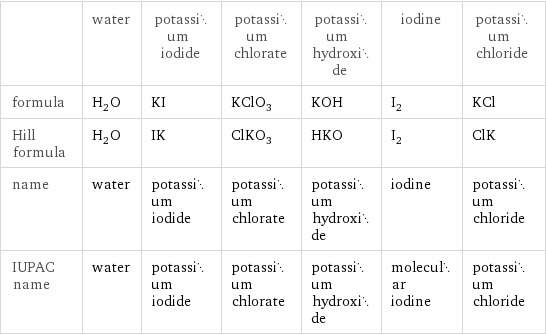
| water | potassium iodide | potassium chlorate | potassium hydroxide | iodine | potassium chloride formula | H_2O | KI | KClO_3 | KOH | I_2 | KCl Hill formula | H_2O | IK | ClKO_3 | HKO | I_2 | ClK name | water | potassium iodide | potassium chlorate | potassium hydroxide | iodine | potassium chloride IUPAC name | water | potassium iodide | potassium chlorate | potassium hydroxide | molecular iodine | potassium chloride
Substance properties
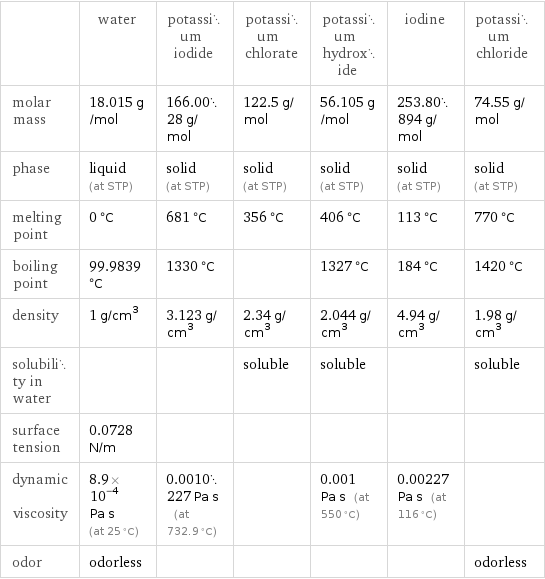
| water | potassium iodide | potassium chlorate | potassium hydroxide | iodine | potassium chloride molar mass | 18.015 g/mol | 166.0028 g/mol | 122.5 g/mol | 56.105 g/mol | 253.80894 g/mol | 74.55 g/mol phase | liquid (at STP) | solid (at STP) | solid (at STP) | solid (at STP) | solid (at STP) | solid (at STP) melting point | 0 °C | 681 °C | 356 °C | 406 °C | 113 °C | 770 °C boiling point | 99.9839 °C | 1330 °C | | 1327 °C | 184 °C | 1420 °C density | 1 g/cm^3 | 3.123 g/cm^3 | 2.34 g/cm^3 | 2.044 g/cm^3 | 4.94 g/cm^3 | 1.98 g/cm^3 solubility in water | | | soluble | soluble | | soluble surface tension | 0.0728 N/m | | | | | dynamic viscosity | 8.9×10^-4 Pa s (at 25 °C) | 0.0010227 Pa s (at 732.9 °C) | | 0.001 Pa s (at 550 °C) | 0.00227 Pa s (at 116 °C) | odor | odorless | | | | | odorless
Units
